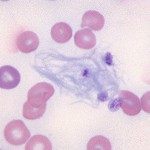Platelet aggregation (clumping) will affect platelet counts. This often results in a falsely decreased count as clumps of platelets will not be counted with any automated hematology analyzers. Similarly, the numbers of platelets cannot be accurately counted manually (with a hemocytometer) in clumped samples (it is impossible to know how many platelets are in a clump). Clumping will also increase the mean platelet volume (MPV; a clump will be “seen” by the analyzer as a single large platelet).
Platelet clumps

Platelets that have not been activated are round to oval discs with dispersed granules. Activation to the point of degranulation can cause platelets to appear as spiculated or amorphous bits of cytoplasm that are difficult to recognize as platelets. Platelets in clumps can be granular or granular. Clumps of degranulated platelets must be distinguished from small flecks of fibrin.
Platelet clumps versus fibrin

Conditions which cause platelet activation and aggregation in a sample (or a patient) may also promote fibrin formation by activation of coagulation. Shown in the image to the right is a tuft of fibrin strands with intermixed platelets. Samples like this may cause mechanical problems (clogging) in automated cell counting devices.
